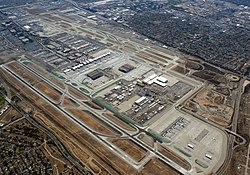
Back Los Angeles Internasionale Lughawe Afrikaans مطار لوس أنجلوس الدولي Arabic مطار لوس انجلوس الدولى ARZ Aeropuertu Internacional de Los Angeles AST Международно летище „Лос Анджелис“ Bulgarian লস অ্যাঞ্জেলেস আন্তর্জাতিক বিমানবন্দর Bengali/Bangla Aeroport Internacional de Los Angeles Catalan Los Angeles International Airport CEB فڕۆکەخانەی نێونەتەوەییی لۆس ئانجلەس CKB Mezinárodní letiště Los Angeles Czech
Los Angeles International Airport | |||||||||||||||||||||||
|---|---|---|---|---|---|---|---|---|---|---|---|---|---|---|---|---|---|---|---|---|---|---|---|
 | |||||||||||||||||||||||
 LAX in September 2014 | |||||||||||||||||||||||
| Summary | |||||||||||||||||||||||
| Airport type | Public | ||||||||||||||||||||||
| Owner/Operator | Los Angeles World Airports | ||||||||||||||||||||||
| Serves | Greater Los Angeles | ||||||||||||||||||||||
| Location | Westchester, Los Angeles, California, U.S. | ||||||||||||||||||||||
| Opened | October 2, 1928 | ||||||||||||||||||||||
| Hub for | |||||||||||||||||||||||
| Operating base for | |||||||||||||||||||||||
| Time zone | PST (UTC−08:00) | ||||||||||||||||||||||
| • Summer (DST) | PDT (UTC−07:00) | ||||||||||||||||||||||
| Elevation AMSL | 39 m / 128 ft | ||||||||||||||||||||||
| Coordinates | 33°56′33″N 118°24′29″W / 33.94250°N 118.40806°W | ||||||||||||||||||||||
| Website | www | ||||||||||||||||||||||
| Maps | |||||||||||||||||||||||
 FAA airport diagram | |||||||||||||||||||||||
 | |||||||||||||||||||||||
| Runways | |||||||||||||||||||||||
| |||||||||||||||||||||||
| Statistics | |||||||||||||||||||||||
| |||||||||||||||||||||||
Los Angeles International Airport[a] (IATA: LAX, ICAO: KLAX, FAA LID: LAX) is the primary international airport serving Los Angeles and its surrounding metropolitan area, in the U.S. state of California. LAX is located in the Westchester neighborhood of the city of Los Angeles, 18 miles (29 km; 16 nmi) southwest of downtown Los Angeles, with the commercial and residential areas of Westchester to the north, the city of El Segundo to the south, and the city of Inglewood to the east. LAX is the closest airport to the Westside and the South Bay.
The airport is operated by Los Angeles World Airports (LAWA), a branch of the Los Angeles city government, that also operates the Van Nuys Airport for general aviation. The airport covers 3,500 acres (1,400 ha) of land and has four parallel runways.[5][8]
In 2023, LAX handled 75,050,875 passengers, making it the world's eighth-busiest airport, according to the Airports Council International rankings.[9] As the largest and busiest international airport on the West Coast of the United States, LAX is a major international gateway for the country, serving as a connection point for passengers traveling internationally (such as East and Southeast Asia, Australasia, Mexico, and Central America).
The airport holds the record for the world's busiest origin and destination airport,[10] because relative to other airports, many more travelers begin or end their trips in Los Angeles than use it as a connection. In 2019, LAWA reported approximately 88 percent of travelers at LAX were origination and destination passengers, and 12 percent were connecting.[11] It is also the only airport to rank among the top five U.S. airports for both passenger and cargo traffic.[12] LAX serves as a hub, focus city, or operating base for more passenger airlines than any other airport in the United States.
Although LAX is the busiest airport in the Greater Los Angeles area, several other airports serve the region including Burbank, John Wayne (Orange County), Long Beach, Ontario, and San Bernardino.
- ^ "Terminal Move Sets The Stage For Allegiant's L.A. Expansion | Allegiant Travel Company". Ir.allegiantair.com. Archived from the original on March 1, 2022. Retrieved February 22, 2022.
- ^ "Southwest Airlines Announces New Crew Base for Pilots and Flight Attendants at Nashville International Airport (BNA)" (Press release). August 14, 2023. Archived from the original on November 6, 2023. Retrieved October 26, 2023.
- ^ "Los Angeles International Airport : Top 10 Carriers : January 2021 through December 2021" (PDF). Lawa.org. Archived from the original on January 31, 2022. Retrieved February 22, 2022.
- ^ a b "Los Angeles International airport – Economic and social impacts". Ecquants. Archived from the original on May 22, 2014. Retrieved September 7, 2013.
- ^ a b FAA Airport Form 5010 for LAX PDF. Effective November 28, 2024.
- ^ "Los Angeles World Airports (LAWA) - Traffic Comparison (TCOM) - Los Angeles International Airport - Calendar YTD January to December" (PDF). Lawa.org. Archived (PDF) from the original on February 14, 2018. Retrieved February 13, 2017.
- ^ "Statistics". Los Angeles World Airports. January 2016. Archived from the original on February 11, 2017. Retrieved July 12, 2016.
- ^ "LAX Airport data at skyvector.com". skyvector.com. Archived from the original on August 22, 2022. Retrieved August 22, 2022.
- ^ Josephs, Leslie (April 15, 2024). "World's busiest airports show surge in international travel. Here are the rankings". CNBC. Retrieved April 15, 2024.
- ^ "A Basic Guide to Los Angeles International Airport (LAX)". Discover Los Angeles. Retrieved June 20, 2023.
- ^ "LAWA Official Website - Just the Facts". Los Angeles World Airports. Retrieved September 9, 2023.
- ^ "Airport Traffic Reports". Airports Council International – North America. Archived from the original on November 3, 2012. Retrieved August 19, 2012.
Cite error: There are <ref group=lower-alpha> tags or {{efn}} templates on this page, but the references will not show without a {{reflist|group=lower-alpha}} template or {{notelist}} template (see the help page).